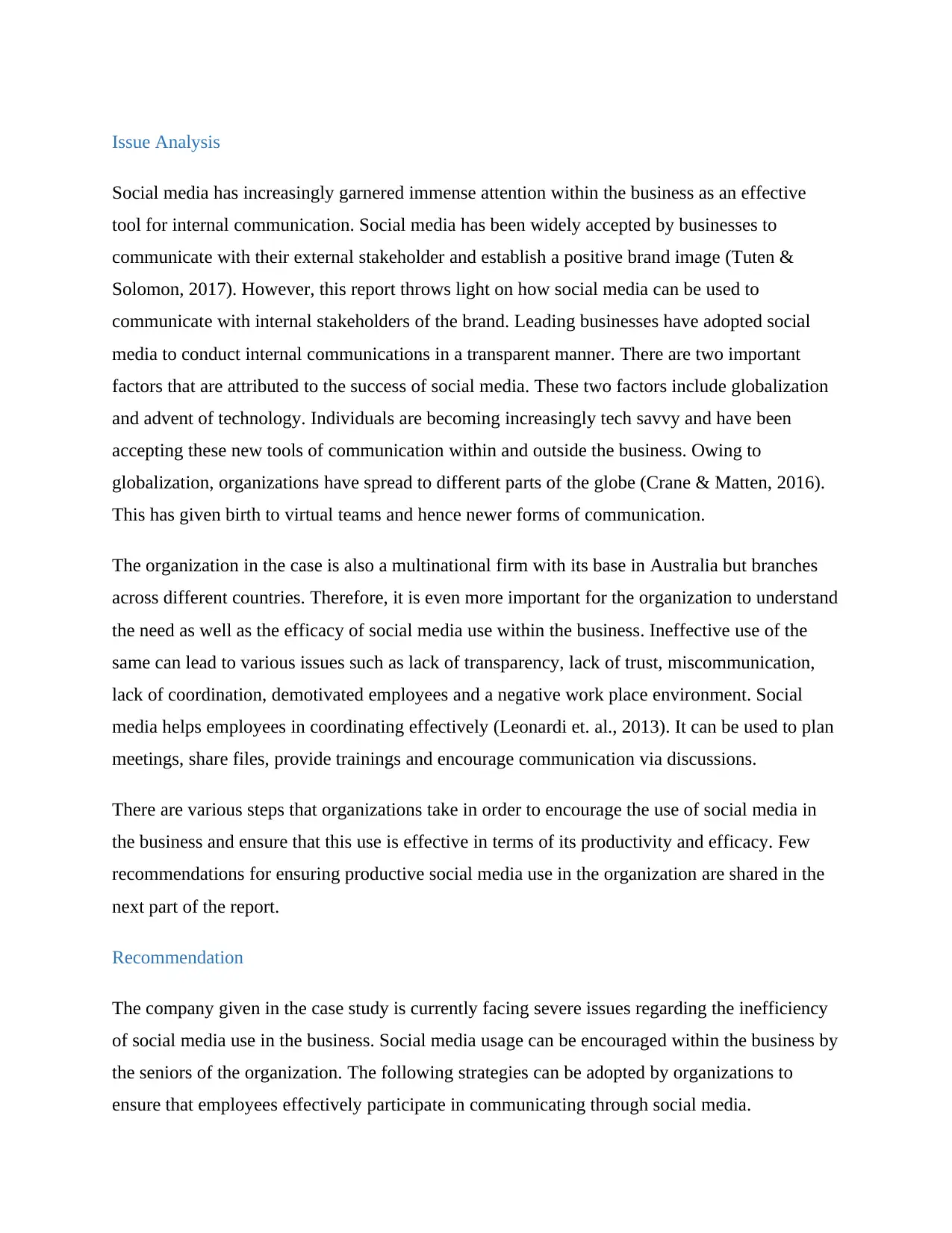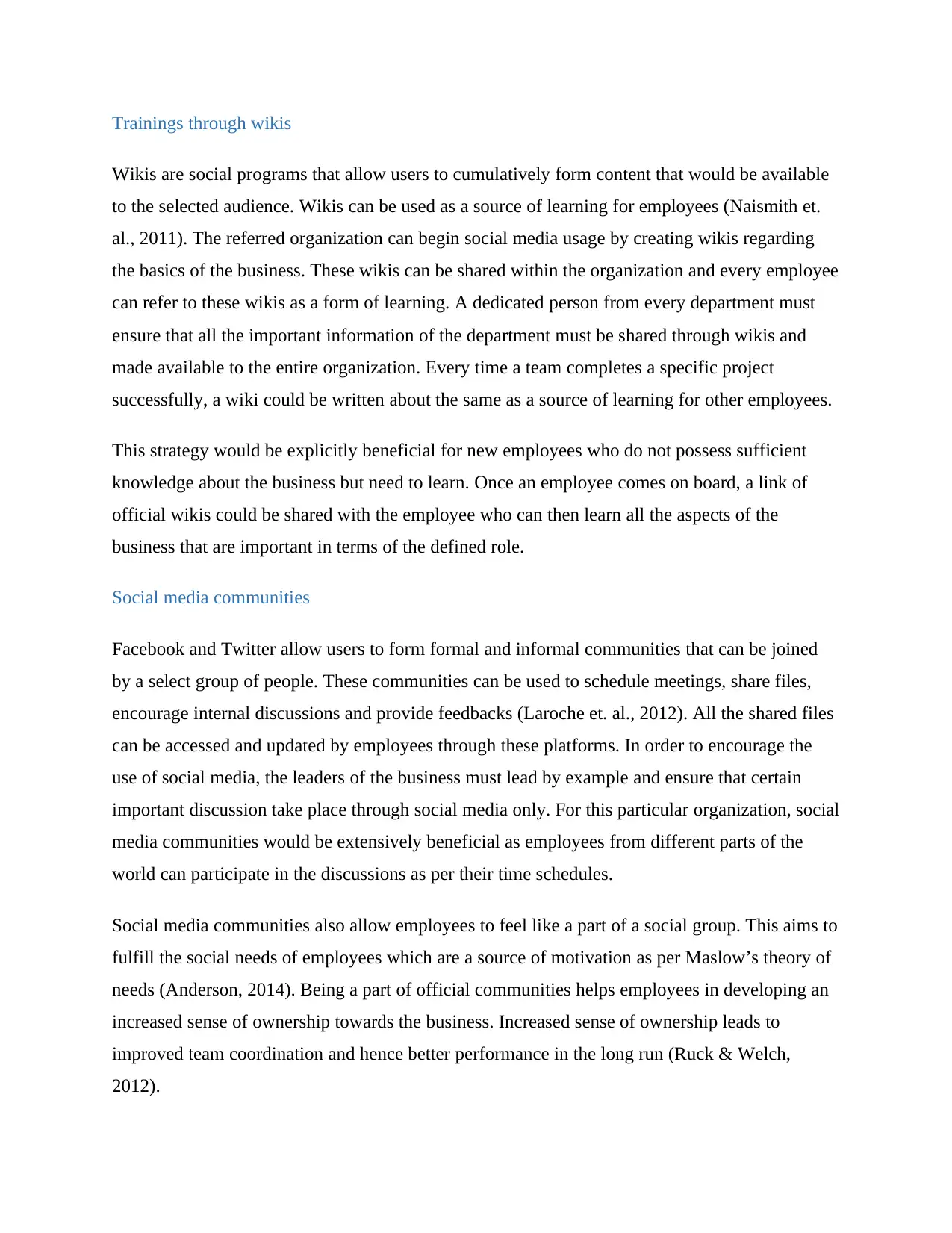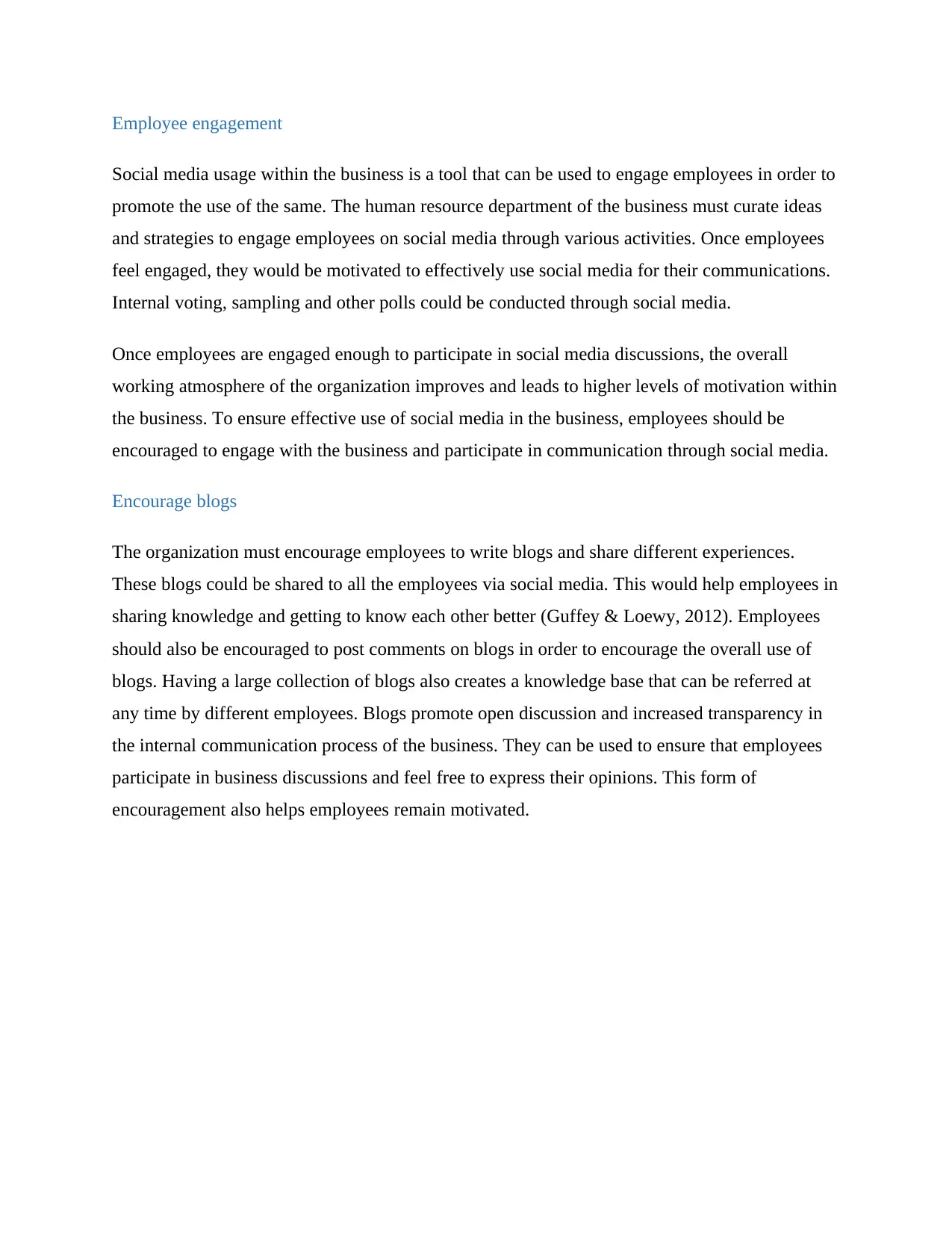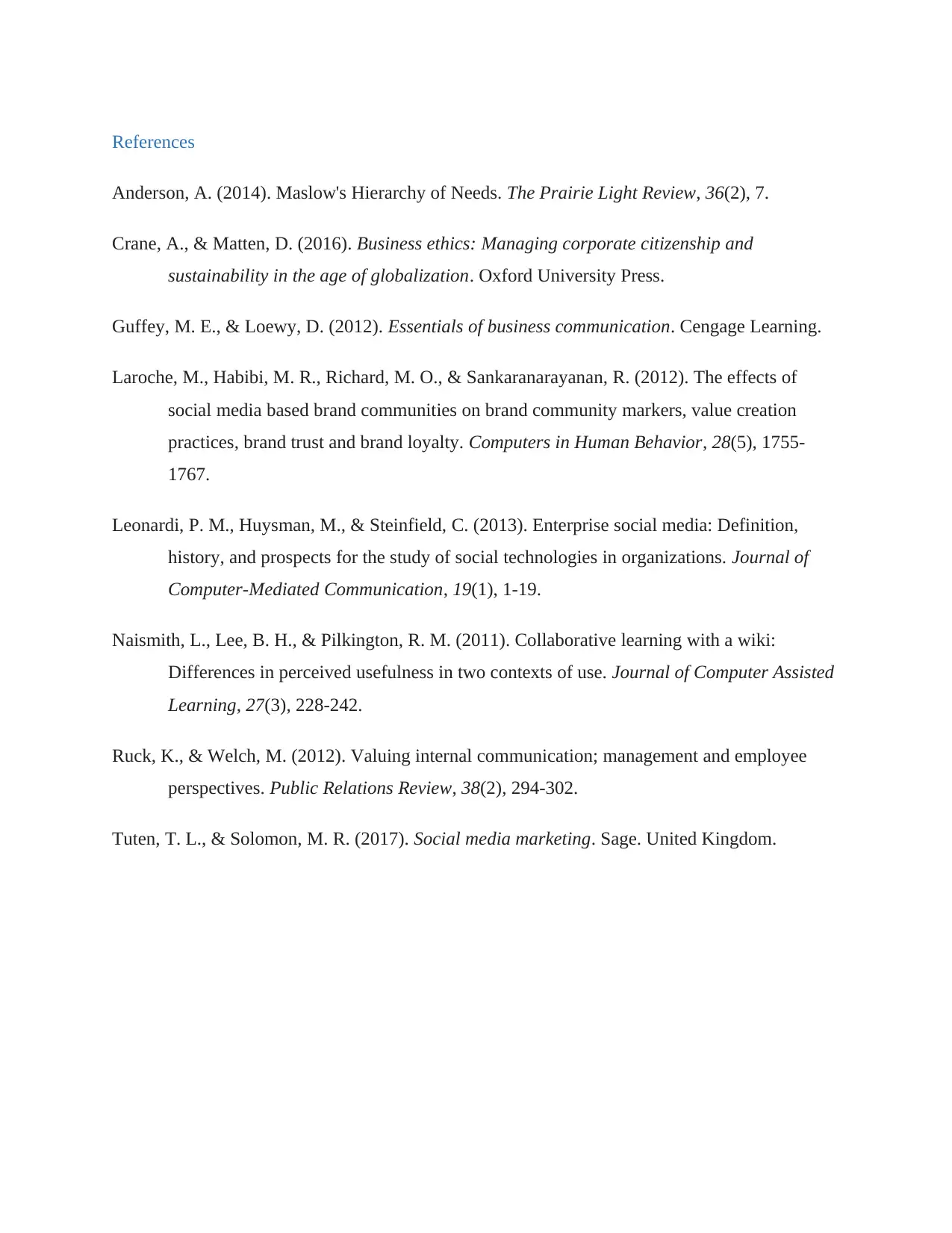Report on Ineffective Social Media Use in Business Communication
VerifiedAdded on 2021/06/15
|5
|1400
|175
Report
AI Summary
This report analyzes the ineffective use of social media in business communication, particularly within a multinational firm. It highlights the importance of social media for internal communication due to globalization and technological advancements, emphasizing that its misuse can lead to transparency issues, miscommunication, and demotivated employees. The report recommends strategies to encourage effective social media use, including creating wikis for knowledge sharing, forming social media communities for discussions and file sharing, engaging employees through interactive activities, and encouraging blogging for open communication and knowledge dissemination. These recommendations aim to improve team coordination, employee motivation, and overall organizational performance by fostering a more transparent and collaborative internal communication environment.

Business communication
Ineffective use of social media in business
Ineffective use of social media in business
Paraphrase This Document
Need a fresh take? Get an instant paraphrase of this document with our AI Paraphraser

Issue Analysis
Social media has increasingly garnered immense attention within the business as an effective
tool for internal communication. Social media has been widely accepted by businesses to
communicate with their external stakeholder and establish a positive brand image (Tuten &
Solomon, 2017). However, this report throws light on how social media can be used to
communicate with internal stakeholders of the brand. Leading businesses have adopted social
media to conduct internal communications in a transparent manner. There are two important
factors that are attributed to the success of social media. These two factors include globalization
and advent of technology. Individuals are becoming increasingly tech savvy and have been
accepting these new tools of communication within and outside the business. Owing to
globalization, organizations have spread to different parts of the globe (Crane & Matten, 2016).
This has given birth to virtual teams and hence newer forms of communication.
The organization in the case is also a multinational firm with its base in Australia but branches
across different countries. Therefore, it is even more important for the organization to understand
the need as well as the efficacy of social media use within the business. Ineffective use of the
same can lead to various issues such as lack of transparency, lack of trust, miscommunication,
lack of coordination, demotivated employees and a negative work place environment. Social
media helps employees in coordinating effectively (Leonardi et. al., 2013). It can be used to plan
meetings, share files, provide trainings and encourage communication via discussions.
There are various steps that organizations take in order to encourage the use of social media in
the business and ensure that this use is effective in terms of its productivity and efficacy. Few
recommendations for ensuring productive social media use in the organization are shared in the
next part of the report.
Recommendation
The company given in the case study is currently facing severe issues regarding the inefficiency
of social media use in the business. Social media usage can be encouraged within the business by
the seniors of the organization. The following strategies can be adopted by organizations to
ensure that employees effectively participate in communicating through social media.
Social media has increasingly garnered immense attention within the business as an effective
tool for internal communication. Social media has been widely accepted by businesses to
communicate with their external stakeholder and establish a positive brand image (Tuten &
Solomon, 2017). However, this report throws light on how social media can be used to
communicate with internal stakeholders of the brand. Leading businesses have adopted social
media to conduct internal communications in a transparent manner. There are two important
factors that are attributed to the success of social media. These two factors include globalization
and advent of technology. Individuals are becoming increasingly tech savvy and have been
accepting these new tools of communication within and outside the business. Owing to
globalization, organizations have spread to different parts of the globe (Crane & Matten, 2016).
This has given birth to virtual teams and hence newer forms of communication.
The organization in the case is also a multinational firm with its base in Australia but branches
across different countries. Therefore, it is even more important for the organization to understand
the need as well as the efficacy of social media use within the business. Ineffective use of the
same can lead to various issues such as lack of transparency, lack of trust, miscommunication,
lack of coordination, demotivated employees and a negative work place environment. Social
media helps employees in coordinating effectively (Leonardi et. al., 2013). It can be used to plan
meetings, share files, provide trainings and encourage communication via discussions.
There are various steps that organizations take in order to encourage the use of social media in
the business and ensure that this use is effective in terms of its productivity and efficacy. Few
recommendations for ensuring productive social media use in the organization are shared in the
next part of the report.
Recommendation
The company given in the case study is currently facing severe issues regarding the inefficiency
of social media use in the business. Social media usage can be encouraged within the business by
the seniors of the organization. The following strategies can be adopted by organizations to
ensure that employees effectively participate in communicating through social media.

Trainings through wikis
Wikis are social programs that allow users to cumulatively form content that would be available
to the selected audience. Wikis can be used as a source of learning for employees (Naismith et.
al., 2011). The referred organization can begin social media usage by creating wikis regarding
the basics of the business. These wikis can be shared within the organization and every employee
can refer to these wikis as a form of learning. A dedicated person from every department must
ensure that all the important information of the department must be shared through wikis and
made available to the entire organization. Every time a team completes a specific project
successfully, a wiki could be written about the same as a source of learning for other employees.
This strategy would be explicitly beneficial for new employees who do not possess sufficient
knowledge about the business but need to learn. Once an employee comes on board, a link of
official wikis could be shared with the employee who can then learn all the aspects of the
business that are important in terms of the defined role.
Social media communities
Facebook and Twitter allow users to form formal and informal communities that can be joined
by a select group of people. These communities can be used to schedule meetings, share files,
encourage internal discussions and provide feedbacks (Laroche et. al., 2012). All the shared files
can be accessed and updated by employees through these platforms. In order to encourage the
use of social media, the leaders of the business must lead by example and ensure that certain
important discussion take place through social media only. For this particular organization, social
media communities would be extensively beneficial as employees from different parts of the
world can participate in the discussions as per their time schedules.
Social media communities also allow employees to feel like a part of a social group. This aims to
fulfill the social needs of employees which are a source of motivation as per Maslow’s theory of
needs (Anderson, 2014). Being a part of official communities helps employees in developing an
increased sense of ownership towards the business. Increased sense of ownership leads to
improved team coordination and hence better performance in the long run (Ruck & Welch,
2012).
Wikis are social programs that allow users to cumulatively form content that would be available
to the selected audience. Wikis can be used as a source of learning for employees (Naismith et.
al., 2011). The referred organization can begin social media usage by creating wikis regarding
the basics of the business. These wikis can be shared within the organization and every employee
can refer to these wikis as a form of learning. A dedicated person from every department must
ensure that all the important information of the department must be shared through wikis and
made available to the entire organization. Every time a team completes a specific project
successfully, a wiki could be written about the same as a source of learning for other employees.
This strategy would be explicitly beneficial for new employees who do not possess sufficient
knowledge about the business but need to learn. Once an employee comes on board, a link of
official wikis could be shared with the employee who can then learn all the aspects of the
business that are important in terms of the defined role.
Social media communities
Facebook and Twitter allow users to form formal and informal communities that can be joined
by a select group of people. These communities can be used to schedule meetings, share files,
encourage internal discussions and provide feedbacks (Laroche et. al., 2012). All the shared files
can be accessed and updated by employees through these platforms. In order to encourage the
use of social media, the leaders of the business must lead by example and ensure that certain
important discussion take place through social media only. For this particular organization, social
media communities would be extensively beneficial as employees from different parts of the
world can participate in the discussions as per their time schedules.
Social media communities also allow employees to feel like a part of a social group. This aims to
fulfill the social needs of employees which are a source of motivation as per Maslow’s theory of
needs (Anderson, 2014). Being a part of official communities helps employees in developing an
increased sense of ownership towards the business. Increased sense of ownership leads to
improved team coordination and hence better performance in the long run (Ruck & Welch,
2012).
⊘ This is a preview!⊘
Do you want full access?
Subscribe today to unlock all pages.

Trusted by 1+ million students worldwide

Employee engagement
Social media usage within the business is a tool that can be used to engage employees in order to
promote the use of the same. The human resource department of the business must curate ideas
and strategies to engage employees on social media through various activities. Once employees
feel engaged, they would be motivated to effectively use social media for their communications.
Internal voting, sampling and other polls could be conducted through social media.
Once employees are engaged enough to participate in social media discussions, the overall
working atmosphere of the organization improves and leads to higher levels of motivation within
the business. To ensure effective use of social media in the business, employees should be
encouraged to engage with the business and participate in communication through social media.
Encourage blogs
The organization must encourage employees to write blogs and share different experiences.
These blogs could be shared to all the employees via social media. This would help employees in
sharing knowledge and getting to know each other better (Guffey & Loewy, 2012). Employees
should also be encouraged to post comments on blogs in order to encourage the overall use of
blogs. Having a large collection of blogs also creates a knowledge base that can be referred at
any time by different employees. Blogs promote open discussion and increased transparency in
the internal communication process of the business. They can be used to ensure that employees
participate in business discussions and feel free to express their opinions. This form of
encouragement also helps employees remain motivated.
Social media usage within the business is a tool that can be used to engage employees in order to
promote the use of the same. The human resource department of the business must curate ideas
and strategies to engage employees on social media through various activities. Once employees
feel engaged, they would be motivated to effectively use social media for their communications.
Internal voting, sampling and other polls could be conducted through social media.
Once employees are engaged enough to participate in social media discussions, the overall
working atmosphere of the organization improves and leads to higher levels of motivation within
the business. To ensure effective use of social media in the business, employees should be
encouraged to engage with the business and participate in communication through social media.
Encourage blogs
The organization must encourage employees to write blogs and share different experiences.
These blogs could be shared to all the employees via social media. This would help employees in
sharing knowledge and getting to know each other better (Guffey & Loewy, 2012). Employees
should also be encouraged to post comments on blogs in order to encourage the overall use of
blogs. Having a large collection of blogs also creates a knowledge base that can be referred at
any time by different employees. Blogs promote open discussion and increased transparency in
the internal communication process of the business. They can be used to ensure that employees
participate in business discussions and feel free to express their opinions. This form of
encouragement also helps employees remain motivated.
Paraphrase This Document
Need a fresh take? Get an instant paraphrase of this document with our AI Paraphraser

References
Anderson, A. (2014). Maslow's Hierarchy of Needs. The Prairie Light Review, 36(2), 7.
Crane, A., & Matten, D. (2016). Business ethics: Managing corporate citizenship and
sustainability in the age of globalization. Oxford University Press.
Guffey, M. E., & Loewy, D. (2012). Essentials of business communication. Cengage Learning.
Laroche, M., Habibi, M. R., Richard, M. O., & Sankaranarayanan, R. (2012). The effects of
social media based brand communities on brand community markers, value creation
practices, brand trust and brand loyalty. Computers in Human Behavior, 28(5), 1755-
1767.
Leonardi, P. M., Huysman, M., & Steinfield, C. (2013). Enterprise social media: Definition,
history, and prospects for the study of social technologies in organizations. Journal of
Computer-Mediated Communication, 19(1), 1-19.
Naismith, L., Lee, B. H., & Pilkington, R. M. (2011). Collaborative learning with a wiki:
Differences in perceived usefulness in two contexts of use. Journal of Computer Assisted
Learning, 27(3), 228-242.
Ruck, K., & Welch, M. (2012). Valuing internal communication; management and employee
perspectives. Public Relations Review, 38(2), 294-302.
Tuten, T. L., & Solomon, M. R. (2017). Social media marketing. Sage. United Kingdom.
Anderson, A. (2014). Maslow's Hierarchy of Needs. The Prairie Light Review, 36(2), 7.
Crane, A., & Matten, D. (2016). Business ethics: Managing corporate citizenship and
sustainability in the age of globalization. Oxford University Press.
Guffey, M. E., & Loewy, D. (2012). Essentials of business communication. Cengage Learning.
Laroche, M., Habibi, M. R., Richard, M. O., & Sankaranarayanan, R. (2012). The effects of
social media based brand communities on brand community markers, value creation
practices, brand trust and brand loyalty. Computers in Human Behavior, 28(5), 1755-
1767.
Leonardi, P. M., Huysman, M., & Steinfield, C. (2013). Enterprise social media: Definition,
history, and prospects for the study of social technologies in organizations. Journal of
Computer-Mediated Communication, 19(1), 1-19.
Naismith, L., Lee, B. H., & Pilkington, R. M. (2011). Collaborative learning with a wiki:
Differences in perceived usefulness in two contexts of use. Journal of Computer Assisted
Learning, 27(3), 228-242.
Ruck, K., & Welch, M. (2012). Valuing internal communication; management and employee
perspectives. Public Relations Review, 38(2), 294-302.
Tuten, T. L., & Solomon, M. R. (2017). Social media marketing. Sage. United Kingdom.
1 out of 5
Related Documents
Your All-in-One AI-Powered Toolkit for Academic Success.
+13062052269
info@desklib.com
Available 24*7 on WhatsApp / Email
![[object Object]](/_next/static/media/star-bottom.7253800d.svg)
Unlock your academic potential
Copyright © 2020–2025 A2Z Services. All Rights Reserved. Developed and managed by ZUCOL.





